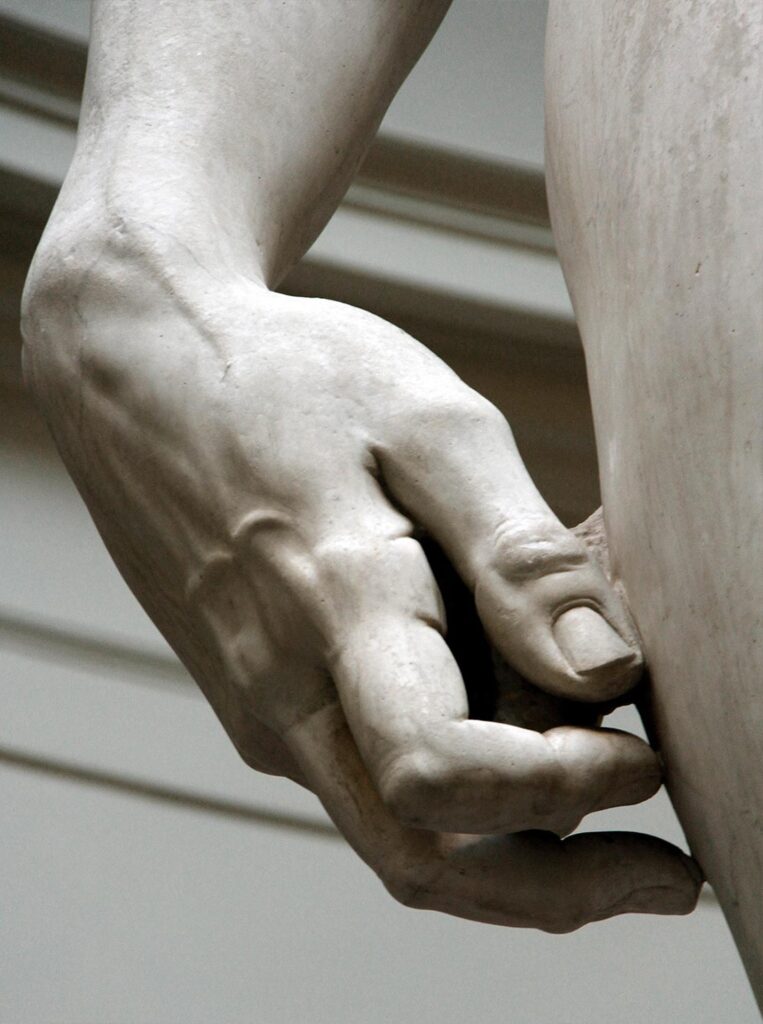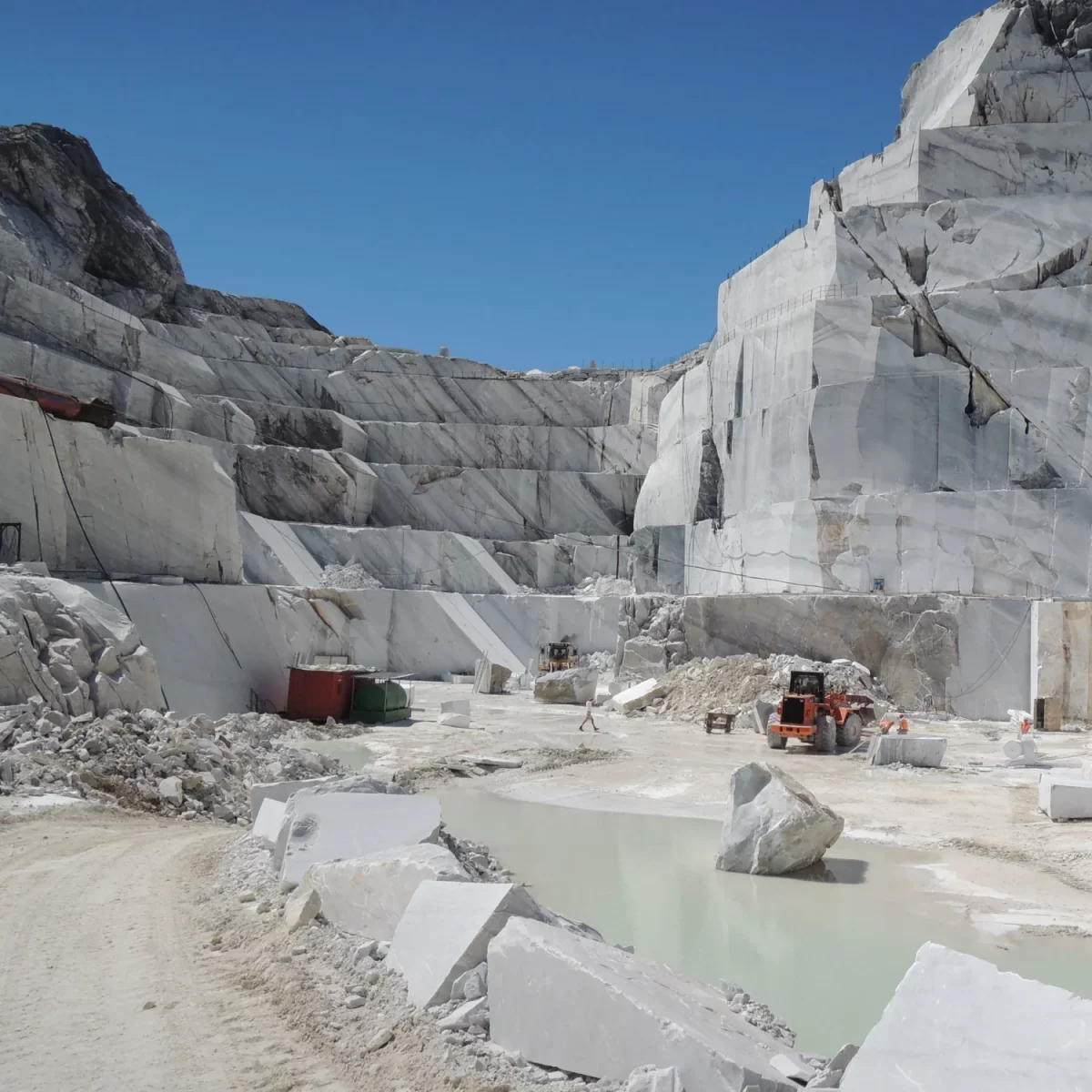The Apuan Alps are ancient Italian mountains located between the Versilia coast of Tuscany and Emilia. They represent the largest and oldest marble basin in the world. The area is also known as “White Gold” due to the quality, beauty, and uniqueness of its white marble. Carrara marble, already used in Roman times, gained its legendary status in the Renaissance. Now, let’s delve into the relationship between Michelangelo Buonarroti and the marble from the Apuan Alps.
Close Relationships
Michelangelo had a close connection with the city of Carrara. He stayed there many times on his frequent visits to the quarries, where he personally selected the marble for his sculptures. His first recorded stay was in the Autumn of 1497, when he traveled to Carrara on horseback to procure the marble needed for the creation of the Pietà, commissioned by the French cardinal Jean de Bilhères-Lagraulas.
Despite unfavorable weather conditions for quarrying work (the temperatures in the high altitudes are cold, and the marble quarries are often covered in snow), the operation proceeded without major obstacles. Michelangelo’s supplier, Matteo Cuccarello, had the marble blocks extracted from the Polvaccio quarry ready for transport in February. However, the blocks only reached Rome at the beginning of summer, possibly due to bureaucratic impediments (even at that time, bureaucracy had already infiltrated daily life).
Michelangelo visited Carrara on many other occasions to select the marble for his works. There were several reasons for this. One was the limited availability of quality marble in Florence and Rome, or other cities distant from the quarries.
Most importantly, Michelangelo wanted to have a deep understanding of the material by being in direct contact with the workers who depended on it for their livelihoods and by frequenting the mines. Through this, the artist managed to fill in the gaps in his knowledge of marble. Until the moment he began the Pietà, he had only ever worked on blocks that were already partially prepared, so he considered these initial phases of material selection as an integral part of creating his masterpieces.

He returned to Carrara in the spring of 1505, shortly after receiving the commission for the funerary monument of Pope Julius II.
The new experiences in the quarries took place during the good season. During his stay in 1505 (which lasted eight months, a sufficient amount of time for the artist to start roughing out the marbles in Carrara, where he stayed until the end of autumn), Michelangelo made direct arrangements for transportation with some boat owners from Lavagna (at that time, most of the ships used for marble transportation from the beach of Avenza were Ligurian).
For the quarry workers, having Michelangelo in Carrara meant having an exceptional client, since the quantities he ordered were always significant, given the magnitude of the artistic endeavors he was called to accomplish.
Art and Politics
The artist again returned to Carrara in 1516, even though he had continued to deal with his regular suppliers in the meantime, with the help of trusted individuals.
Unfortunately, times had changed. Julius II had passed away, and the funerary monument was far from completion. The heir, Francesco Maria Della Rovere, Duke of Urbino, imposed a deadline of seven years on the sculptor to finish the work (a deadline that was not ultimately met).
Michelangelo also found himself engaged in a tough battle with the new Pope Leo X (born Giovanni de’ Medici), who insisted that the artist use marble from the quarries of Pietrasanta (a city under Medici rule) instead of Carrara marble. But the artist did not want to leave Carrara, not only because he had established a long-standing network of relationships on the Apuan Riviera but also because the Pietrasanta quarries had not yet been worked, and initiating their development (with all that it entailed, such as identifying sites, training professionals, and creating transportation routes) was an overwhelming task that Michelangelo did not want to undertake.
During this stay, which began in September of 1516, the artist rented a house in Piazza del Duomo and started negotiations, as usual, with the quarry workers.
In December, however, he received a letter from Rome accusing him of favoring Carrara marbles over those from Versilia, despite the Pontifical Curia expressly requesting him to use the quarries of Seravezza. Michelangelo, however, not only ignored the accusations coming from the Papal States but continued to work diligently in Carrara (where he stayed until August 1517).
He co-founded a company with a Carrara quarry worker, Leonardo Cagione, to initiate the exploitation of a new quarry, with the dual purpose of facilitating the supply of marble and also profiting from the supplies. The two would split both expenses and profits equally.
Michelangelo briefly had the situation in his favor, as his determination led the Medici family to grant him the freedom to choose whether to source from Carrara or Seravezza for the project of the new façade of the Basilica of San Lorenzo in Florence. However, a series of serious disputes with the owners of the Carrara quarries and tensions with the Marquis of Massa, Antonio Alberico II Malaspina, pushed him to leave Carrara and go to Seravezza to source marbles from the new quarries in the province of Lucca, in Tuscany.
However, his relationship with Carrara did not come to an end. In Seravezza, the artist ran into difficulties, mainly due to the very limited skills of the local workers (to the extent that he had to act as their teacher). After expressing his complaints to the Pope, he received a response stating that he could comfortably source marble from Carrara for use in San Lorenzo. He returned to the Apuan Riviera in 1519, following the improvement of relations with some suppliers.
The Final Act
Michelangelo returned to Carrara one last time in 1521, to choose the marble for his new Medici commission, the New Sacristy. The last contract with Carrara is dated 1523. During that time, the artist did not personally visit the city but sent his friend and trusted collaborator, the stonecutter Domenico da Settignano, known as “Topolino,” who had accompanied him to the Apuan quarries on several occasions.
On this occasion, Topolino supervised the extraction of the blocks on his behalf and continuously sent letters to Michelangelo to inform him of the progress. From the letters exchanged with various correspondents we know that, with Topolino’s help, Michelangelo maintained a relationship with Carrara at least until 1525. After that date, for various reasons (political changes, new projects, advancing age), Michelangelo no longer had the need to directly engage with the people of Carrara to obtain marble.
The relationship with Carrara lasted for about thirty years. It was often tense and challenging, influenced by the artist’s notoriously difficult character, the rough and proud temperament of the Apuan quarrymen, and the adverse weather conditions. However, none of these factors prevented Michelangelo from personally selecting the marble for the execution of his works. This demonstration of the artist’s professionalism and genius is evident in every detail of his masterpieces.


6 replies on “White Gold and Michelangelo”
Wooowww!
What a beautiful, very interesting story! It brought humanity to a sacred artist as Michelangelo!! I saw the man! Thank you Lea
Thanks!
Fascinating stuff! I had no idea he was so much of an entrepreneur as well as a artistic genius.